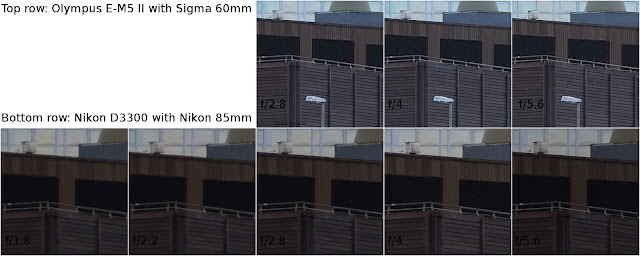The Sigma 60mm f/2.8 DN used on the Olympus E-M5 II (left) is designed for mirrorless cameras with an APS-C sized sensor, e.g., Sony E, where it becomes equivalent to 90mm, a classic portrait lens. However, it also comes with a Micro Four Thirds mount, where it becomes a 120mm equivalent lens, i.e., a long portrait lens.
On the right, there is the Nikon 85mm f/1.8G. It is designed for use on fullframe cameras, where it is a, you guessed it, 85mm equivalent lens. However, I have mounted it to a Nikon D3300. As it has an APS-C sized sensor, the lens becomes equivalent to 128mm, also a long portrait lens.
To understand why 85mm is commonly referred to as the portrait lens focal length, please read this article.
| Lens | Sigma 60mm f/2.8 DN | Nikon 85mm f/1.8G |
| Lens elements/groups | 8/6 | 9/9 |
| Minimum focus | 0.50m | 0.80m |
| Diameter | 61mm | 80mm |
| Length | 56mm | 73mm |
| Filter thread | 46mm | 67mm |
| Weight | 190g | 350g |
How do they compare in terms of image quality? To find out, I took some example images at different apertures find out. These were taken at a focus distance of about 15m, at ISO 200.
I used a tripod, of course, and I used live view for the most precise autofocus. That avoids the potential problems of frontfocusing (FF) and backfocusing, a major concern for some DSLR users. Click for larger images:
| Sigma 60mm f/2.8 DN @ f/2.8 | Nikon 85mm f/1.8G @ f/1.8 |
To make the images easier to compare, here are 100% crops from the centre of the pictures:
And from the lower left corner:
And here is a series taken from a bigger distance:
| Sigma 60mm f/2.8 DN @ f/2.8 | Nikon 85mm f/1.8G @ f/1.8 |
Again, here are 100% crops from the centre of the image, click for a larger view:
And from the lower right hand side:
Conclusion
The Nikon 85mm f/1.8G is the fastest of the two, in terms of aperture, of course. But the test here shows that the Sigma 60mm f/2.8 DN is still sharper at f/2.8. The Nikon lens needs to be stopped down to near f/4 to obtain the same sharpness.
On the other hand, there are times when you'd want to trade a faster aperture for less sharpness, and if so, you may still want the larger aperture of the Nikon lens. But if you value compactness and are prepared to use a high ISO, the Sigma lens is the way to go.









This comment has been removed by the author.
ReplyDeleteThanks for finding the typo!
DeleteIf you want the faster aperture you have a problem, because the other lens is for a different system...
ReplyDeleteGood article dear ... but
ReplyDeleteOn M43 for the same DOF (the same image result) you must compare the f2.8 sigma to f4.2 Nikon.
... you wrote, it's the same result at F4 for the nikon compare to the sigma f2.8 on the M43.
It mean, in term of sharpness, theses 2 lens are equivalent.
Of course the result will very different with Sony Nex ... but the sigma become a 90mm, and it's not the same.